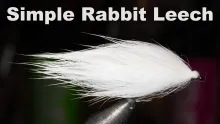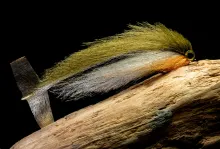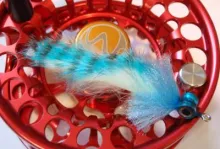This is a well know species that is easily identified. Key characteristics are the strongly compressed rather elliptical body, a small pointed head, strongly downward curving lateral ling, a long sickle-shaped anal fin, and a thin scaleless keel on the midline of the belly behind the pelvic fins.

Introduction
This feature is part of a series of articles being created as a group effort by members of the Streamer List to provide some background information on the species of forage fish we most commonly try to immitate with streamer patterns. Many thanks to the Lindsey Grandison for organizing this effort, and to the list members who contributed patterns and other information!
Golden Shiner (Notemigonus cystoleucas)
This description of the Golden Shiner was submitted by Doug Saball
This is a well know species that is easily identified. Key characteristics are the strongly compressed rather elliptical body, a small pointed head, strongly downward curving lateral ling, a long sickle-shaped anal fin, and a thin scaleless keel on the midline of the belly behind the pelvic fins. The coloration is a dark olive-green on the back, becoming a golden-silver on the sides. With large adults a deep golden or brassy coloration is prominent. The fins are yellowish with the lower fins turning orange on breading males. Young golden shiners have a distinctive broad dark lateral band, more silvery than gold body, and their fins are transparent. (1,2)
Distribution: On the east coast of North America from the Maritime Provinces south to Florida and west to the Dakotas and Texas. Because of its wide use as bait, it has been introduced into many parts of the western United States to which it is not native. (2)
Habitat: The golden shiner is found in the quiet waters of lakes, ponds and sluggish rivers and streams. They prefer areas with thick vegetation and muddy bottoms. The golden shiner is usually found with such species as the chain pickerel, brown bullheads, yellow perch, and largemouth bass. (1,2)
Reproduction: The golden shiner spawns in late spring and summer. It scatters its adhesive eggs over submerged vegetative beds in quiet waters. Females are known to produce as much as 200,000 eggs in a season. The spawning season may last for the whole summer with several spawns throughout the season. Usually the first spawn is the largest. But this is dependent on specific areas, weather and water conditions. (1,2)
Age and Growth: The golden shiner reaches a maximum length of about 12 inches, however, some specimens have been collected that reach as large as 15 inches. (3) Typical adult golden shiners are 4 to 7 inches. It is a rapid grower usually reaching 2 to 3 inches in one year. However, in colder regions the golden shiner reaches maturity in its third summer, and may only be 3 inches. (1,2)
Food: The golden shiner eats an extremely diverse assortment of food. Its long fine gill rakes, long intestine, and strong grinding pharyngeal teeth equip it for feeding on all types of foods. It can strain microorganisms, digest cellulose-containing plants, and crush small mollusks. It eats alga, plant fragments, water fleas, insect larva, snails, clams, and occasionally small fish. (1)
Remarks: This species is primarily valuable as a forage food for game fish. Because it reproduces rapidly in ponds and its food consists largely of vegetation, it has often been stocked extensively as a forage fish. The golden shiner is one of the more commonly used baitfish in New England primarily because of its availability and silvery appearance. However, the golden shiner is difficult to keep alive in a bait bucket or on a hook. It is used locally to some degree as a "sewn-on shiner" in trolling for lake trout and salmon. (1)
Common Names: Golden shiner, roach, bream, butterfish, eastern golden shiner, American roach, American bream, sunfish, dace, bitterhead, chub, gudgeon, young shad, windfish, and goldfish. (2)
Bibliography
- Freshwater Fishes of New Hampshire, John F. Scarols, New Hampshire Fish and Game Department, Division of Inland and Marine Fisheries, 1973.
- Freshwater Fishes of Canada, Bulletin 184, Scott, W.B., E.J. Crossman, Fisheries Research Board of Canada, Ottawa 1973.
- General Limnological Survey of Brimfield Lake, Sturbridge, MA. US Army Corps of Engineers, Water Quality Laboratory, Barre Falls MA. Peter Trinchero, John Vierra, and Douglas Saball. 1982 (unpublished).
Pattern Listing
ZWIRZ AND EVANS' GOLDEN SHINER
Submitted By Lindsey Grandison

| HOOK | 4XL streamer hook |
| TAIL | pale yellow hackle |
| BODY | pale yellow angora; under body is shaped to be tapered front and back |
| THROAT | orange hackle |
| WING | two pale orange feathers over which are two medium olive marabou feathers, tips extending to end of tail |
| MYLAR | a piece of mylar approximately one quarter inch wide, tied in at the head and extending slightly passed the hook, themylar is tappered at the tail end |
| HEAD | yellowish painted with clear lacquer |
| COMMENTS | This is another one of the Miracle Marabou patterns originatedby Bob Zwirz and Kani Evans. Bob Zwirz ran the Angler's Cove in New YorkCity which back in the 60's had a cult like reputation amongst New Yorkcity fly tiers. His small cubby hole of a shop located on an upper floorof a building had everything conceivable including a quirky shop owner. This series of patterns was published in Field and Streamer in its March1963 issue. The unique feature of these patterns is the inclusion of aside strip of mylar. It is intended to reproduce the flash and reflectionthat can comes off the sides of the fish. Joe Bates' "Streamer Fly Tyingand Fishing" gives the complete series of these innovative but forgottenflies. |
DAVE WHITLOCK'S GOLDEN SHINER
Submitted By Lindsey Grandison

| UNDERBODY | Lead strip or a strip of any other material which is mounted on the hook shank. The underbody is shapedto represent the general outlines of a bait fish. |
| BODY | Gold mylar tubing stretched over the underbody. The tubing is cut flush and tied in at the hook eye.The tubing extends slightly beyond the bend. It is tied in at the bend and the additional material beyond the bend is unravelled. |
| CHEEK | Brown pheasant feather |
| EYE | Stick-on mylar eye or a doll's eyes. |
| WING | A olive strip of rabbit hair, a zonker strip. Thisis tied in at the hook eye, extends along the hook shank, is tied in at the bend and extends passed the bend for approximately a hook gape or more. |
| COMMENTS | This is one of the Dave Whitlock's Match the Minnow series. The distinctive feature is the placement of the body on the shank oppositethe hook point. Consequently the hook point rides upside down. Thisconstruction eliminates any reduction in the hook gap resulting from thedeep body. This series like the rest of Dave Whitlock's designs producesvery realistic flies. The Match the Minnow series can be found in DickStewart's "Bass Flies". |
SIMPLE GOLDEN SHINER
Submitted By Lindsey Grandison

| BODY | silver tinsel |
| WING | yellow bucktail under either blue-gray bucktail or peacock herl |
| COMMENT | This pattern is the suggestion of Joe Bates. In his classic "Streamer Fly Tying and Fishing" he has a chapter describing how toselect flies based on the baitfish that they imitate. When he comes tothe golden shiner he indicates that a very simple fly is all that isnecessary and gives the pattern above. The only note in construction thathe adds concerns the the body shape of the golden shiner. Unlike manyother baitfish it has a deeper body ( dorsal to ventral ) and accordinglythe body should replicate this. |
NEK GOLDEN SHINER
Submitted By Roger Whitcomb

| HOOK | Mustad #94720, size 4 |
| TAG | Gold tinsel |
| TAIL | Golden pheasant tippets w/ few bright orange hackle fibers covering. |
| BODY | Gold tinsel double-wrapped. |
| RIB | Medium oval gold tinsel wound with little space between wraps. |
| WING | Dark olive grizzly hackle flanked by two golden olive hackles over 4-8 hairs of white and orange bucktail. |
| THROAT | Orange hackle collared, divided, and pulled down. |
| SHOULDER | Finely marked mallard dyed dark olive. |
| CHEEKS | Jungle Cock |
| HEAD | Black |
A local pattern, the NEK (Northeast Kingdom of Vermont) Golden Shiner is used successfully for Squaretails, Landlocks, Lakers, and Rainbows in casting and trolling sizes including tandems. I tie it as above, but many others use strands of gold flashabou the same length as the wing along with orange for the throat. The originator is unknown, but there are several variations of this pattern used in this area.
COBBOSSEE (GOLDEN) SHINER
Submitted By Chris DelPlato

| HOOK | Martinek Rangeley 8xl |
| BODY | Large Holographic Gold Mylar Tinsel |
| BELLY | Yellow Bucktail, under which is White Bucktail. Sparse. |
| THROAT | Red Schlappen |
| WING | Two Yellow hackles inside. Covered by two lightly marked, slightlyiridescent Honey Badger hackles. |
| TOPPING | Three or Four Peacock Herls |
| SHOULDER | Mallard Flank, lightly marked |
| CHEEK | Jungle Cock (optional) |
Designed by 'yours truly' for use on Cobbosseecontee Lake (Kennebec County, Maine) which has a good golden shiner population, as well as large and smallmouth bass that feed on them. My intent was to create a larger
pattern, since this baitfish can grow to a fairly large size. The fly proved to be quite productive during a two week trial in July '99. Both types of bass seemed to take the fly readily, including its first victim - a 3 lb. smallmouth.
E.J.'S GOLDEN SHINER
Submitted By Emmett Johnson

| TAIL | Bronze mallard |
| BODY | E-Z Body Tubing |
| THROAT | Red schlappen |
| LATERAL LINE | Orange Krystal Flash |
| UNDERWING | Peacock Herl |
| WING | Tan saltwater bucktail, yellow dyed polar bear, and mandarin wood duck, tied flat on top. |
| EYE | Prizm Eye |
GOLDEN SHINER
Submitted By Robb Nicewonger

| HOOK | TMC 300, #6 |
| TAIL | Silver krystal flash |
| BODY | Silver tinsel |
| BELLY | White craft fur |
| WING | Gray over yellow bucktail, over silver krystal flash. |
| HEAD | Monothread w/ painted red throat and mylar eyes. |
GOLDEN SHINER
Submitted By Bob Petti

| HOOK | Mike Martinek 8XL#2 |
| TAIL | Holographic GoldAngel Hair |
| BODY | Gold Diamondbraid |
| BELLY | Yellow bucktail |
| WING | Yellow Grizzly insideGolden Orange hackles |
| THROAT | Red Hackle barbules |
| SHOULDERS | Wood Duck Flank |
| CHEEKS | Jungle Cock |
- Log in to post comments








Thanks for the infor
Thanks for the informative information. A great help.